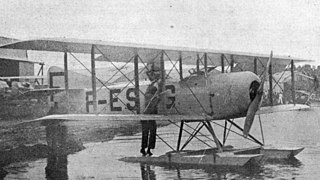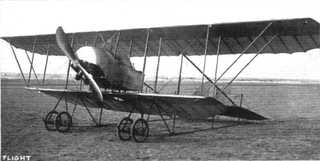The Caudron C.99 was a French light bomber and reconnaissance aircraft. The only example flew with different engines in the mid-1920s.

The Caudron C.101 and its variants, the C.103, C.104 and C.107 were French two seat reconnaissance aircraft flown from 1925, differing in their engines.
The Caudron C.91 was a French single engine biplane with an enclosed passenger cabin seating four. It first flew in 1923.

The Caudron C.65 was a single seat biplane floatplane designed and built in France in 1922. Only one was completed.

The Caudron C.43 was the first French five-engined aircraft, a biplane intended for passenger transport or military use and multi-engined for safety. A development of the three-engined Caudron C.39, it had one tractor configuration engine in the nose and two push-pull pairs between the wings. It was capable of carrying eight passengers but was not developed.

The Caudron C.39 was a French three-engined biplane with a cabin for six passengers when the aircraft was equipped as a landplane or four passengers when on floats. It was flown with some success in competitions in 1920 and 1921.
The Caudron C.37 was a French three-engined biplane passenger transport, built in 1920. It could carry six passengers.

The Caudron C.33 "Landaulet Monsieur-Madame" was a French twin engined biplane with four seats, two in open cockpits and two in an enclosed cabin.
The Caudron C.22 was a French twin engine night bomber built in 1917. It did not reach production.
The Caudron C.21 was a French twin engine biplane built just after World War I, able to carry three passengers in an open cockpit.
The Caudron 02 was a French high altitude single seat fighter that was flown in November 1917.

The Caudron Type O was a French single seat air racing biplane first flown in 1914.

The Caudron Types M and N were small, fast French sports monoplanes, flown 1911–13 under a wide range of engine powers. There was also a military version.
The Caudron Type H was a collective name for three different Caudron designs of 1912-3. One of these was an amphibious three seat biplane built for the French military. Two were completed, one appearing at the Paris Aero Salon in November 1912.

The Caudron Type L was a two-seat French pusher configuration amphibious biplane, flown around 1913 and intended for naval use.
The Caudron Type B was a 1911 development of the earliest Caudron type, the Caudron Type A, with a nacelle style fuselage and more powerful engine. Initially an equal span biplane, it was modified into a sesquiplane.
The Caudron Type B Multiplace was a large French biplane designed to carry up to five passengers in a cross country time trial of 1912. It was destroyed early in the event.
The Caudron Type C was a single seat French biplane, intended for military evaluation. Two were built in 1911.

The Caudron Type F was a French single seat biplane produced just before World War I. A dozen were bought by China and at least two other examples, with different engines, competed in 1913, coming first and second in the biplane category of the cross-country race at Reims. Flown by Pierre Chanteloup, one was the first biplane to loop-the-loop.

The Caudron Type D was a French pre-World War I single seat, twin-boom tractor biplane, a close but slightly smaller relative of the two seat Caudron Type C. More than a dozen were completed, one exported to the United Kingdom, where they may also have been licence built, and three to China.












